People: A Story of Perseverance

Vandi Verma is the Chief Engineer for Robotic Operations for the Mars 2020 Perseverance Rover.She talks to Khabar about her journey from India to NASA, the significance of space exploration, and why we should all care.
Being an air force officer’s daughter, Vandi Verma was always comfortable around planes. But little did she know that one day she’d be flying helicopters and driving rovers—not on Earth, but on Mars.
In fact, Verma’s journey to NASA’s jet propulsion laboratory (JPL) began in Halwara,a small town in Punjab, when someone gifted a young Vandi a book on the solar system and planets.Fascinated, she saw the promise of space exploration as she went on to read about Apollo 11, the first manned mission to the moon, and then the Sojourner Rover which was part of the Mars Pathfinder Mission. She decided to pursue a career in robotics and today, as the Chief Engineer for Robotic Operations for the Mars 2020 Perseverance Rover, Verma codes for and drives the Mars rover.
Let’s start at the very beginning. I understand you grew up in a small town called Halwara in Punjab?
Halwara was where I graduated high school from, but I was born in Gujarat and then grew up in several places. We were in Gujarat, in Pune, and in Punjab. We were in all these different towns. These were small towns where the air force bases were in India. And so we moved pretty much every one or two years.
Growing up, did you always have your sights on NASA, working in space and robotics?
I think there’s definitely an element of that. I grew up around planes. I certainly didn’t know about Robotics because it wasn’t as prevalent then, but I did think of automatic flying planes which I found quite interesting.
Also, at the time, they didn’t have women in the Indian Air Force. But as a child, you don’t see those boundaries. You are just imagining things, and you don’t see the hurdles. That’s how I started getting interested at a very young age. But I certainly didn’t know how to connect any of the dots to what I was interested in. I didn’t know a single person who was associated with NASA or space exploration.
Were you a tinkerer growing up? Would you call yourself a techie?
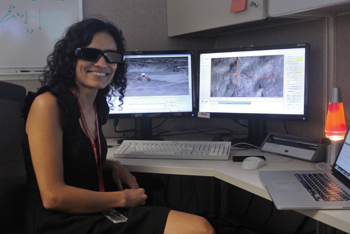 Oh, I absolutely loved figuring things out and building. At that same birthday [when I got the book on the solar system], I also got this Lego set. I would build these entirely complicated structures, and that too from memory. I also enjoyed needlework. I loved the craft and I used to do a lot of embroidery for competitions. So, it wasn’t just tech, but more about innovation. It was about understanding how things work and creating something new. That’s why I always tell students that it may seem that you don’t have access to the kinds of things people might have in other parts of the world, but that’s alright. It’s important to learn the fundamentals and learn how you can put the pieces together. The absolute things that you learn will probably not stay relevant for too long because technology moves so fast. But that skill of how to understand and apply it, will always stay relevant.
Oh, I absolutely loved figuring things out and building. At that same birthday [when I got the book on the solar system], I also got this Lego set. I would build these entirely complicated structures, and that too from memory. I also enjoyed needlework. I loved the craft and I used to do a lot of embroidery for competitions. So, it wasn’t just tech, but more about innovation. It was about understanding how things work and creating something new. That’s why I always tell students that it may seem that you don’t have access to the kinds of things people might have in other parts of the world, but that’s alright. It’s important to learn the fundamentals and learn how you can put the pieces together. The absolute things that you learn will probably not stay relevant for too long because technology moves so fast. But that skill of how to understand and apply it, will always stay relevant.
What prompted you to take up Robotics at Carnegie Mellon University after you finished engineering at Punjab Engineering College?
I remember that during the 1982 Asian Games in New Delhi, they converted one of the stadiums to conduct computer classes. I learnt basic programming there and that really appealed to me. It was different from Math. I have always loved Math,but programming was different. It was the logic used in programming which fascinated me.
It was around the same time that I came to the U.S., and I remember reading about the Sojourner Rover in the newspaper. I found it amazing that it had landed on Mars. I had never heard of anything like that before, and I think it planted a seed in my mind. That’s when I took a class on mobile robot programming at Carnegie Mellon. There I participated in a competition where we had to program our robots to navigate amaze on their own. I spent all my free time coming up with solutions. I was so fast that I ended up winning that competition. Carnegie Mellon introduced me to space robotics, and I realized that though we did not yet have the ability to send human beings to Mars, we could send robots, and this was a way for us to explore.
At the time, robotics was a very new field and luckily the people that I got to associate with believed in the possibility of robotics.
Tell us a little bit about your work with the Mars Rover projects at NASA.
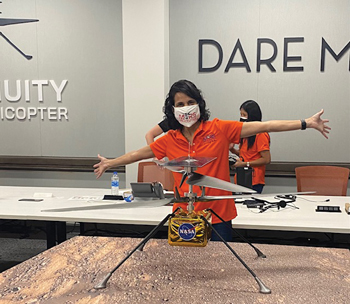 When I started working at NASA in 2004, I worked on the Spirit and Opportunity rovers. It was supposed to be a 90-day mission, but the rovers lasted for over a decade. I was driving those rovers on Mars and it was a great experience.You are solving a new problem every day. [Everyday] there’s a new picture from Mars. You have to figure out how to safely drive the Rover to the next position. You don’t get second chances. We deploy our robotic arm in close proximity, there’s a lens, and some deep, delicate instruments. If anything gets damaged, there’s no replacing it. I love that aspect of it.
When I started working at NASA in 2004, I worked on the Spirit and Opportunity rovers. It was supposed to be a 90-day mission, but the rovers lasted for over a decade. I was driving those rovers on Mars and it was a great experience.You are solving a new problem every day. [Everyday] there’s a new picture from Mars. You have to figure out how to safely drive the Rover to the next position. You don’t get second chances. We deploy our robotic arm in close proximity, there’s a lens, and some deep, delicate instruments. If anything gets damaged, there’s no replacing it. I love that aspect of it.
The reason we do a lot of autonomous things on Mars is because it is so far away. So, when we are commanding a rover on Mars, we can’t do it in real time. It can take a signal anywhere from four minutes to 24 minutes, to even reach Mars. So, if you hit the brakes, it can be up to 24 minutes before the Rover even gets the message. That’s why you have to make it so it can make its own decisions, and that’s the part I’ve always liked—making robots more autonomous.
While I was working on Spirit and Opportunity, I started working on the development of Curiosity. So, I got to be part of Curiosity right from the beginning, even before we had a single motor. I worked on all kinds of different parts; I worked on making the software of the Rover more intelligent. I worked on the sampling system and that was an amazing mission because it was the first time that we were doing the sky crane maneuver with a supersonic parachute.I usually don’t work on the cruise, entry, and descent of the rover—I work on the robotics—but being there for the landing was really special, because everything we do depends on that success.
I got to do Mars time with Curiosity where,in the initial part, we operated in Mars time. We would work through the Mars night. So whenever it’s night on Mars, we would send the commands, create a plan and send it to the Rover. That way, by the time it’s daytime on Mars, it starts executing it and then sends us the data. But the Mars day is 40 minutes longer than the day on Earth, so you have to plan accordingly. I really enjoyed being part of the early mission because nobody knows anything about where exactly we will land even though we have some idea.
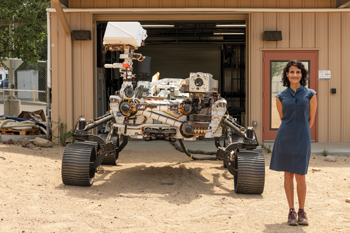 I started working on developing Perseverance while I was still driving Curiosity. You get to learn from every robot you have worked on. Right from day one, when we first unfolded the robotic arm, there are things I developed and code I wrote like the one to prevent the robot’s body from hitting itself. It’s cool when what you code works because you see some things that you created or figure out new ways of doing things.
I started working on developing Perseverance while I was still driving Curiosity. You get to learn from every robot you have worked on. Right from day one, when we first unfolded the robotic arm, there are things I developed and code I wrote like the one to prevent the robot’s body from hitting itself. It’s cool when what you code works because you see some things that you created or figure out new ways of doing things.
It’s one thing to operate a robot in a controlled environment like a forest or a desert where we know the landscape and the terrain, but what is it like to drive a robot in an uncontrolled environment like Mars where you have no idea how things are going to be?
But that is the fun part! I have been building and operating robots for Mars for the last 13 years. So now, it’s a very familiar place in some ways and yet, it constantly surprises you. You can then start extrapolating to the future and develop new technologies based on what worked and what didn’t. You have to constantly ask yourself—what if this assumption is violated? That’s the part of robotics that’s really interesting in that you’re interacting with the real world. And when the real world is Mars, there’s bound to be some inaccuracy. Sometimes it could be millimeters, sometimes centimeters of error; but you must factor that uncertainty in when you make the calculations.
In general, with robotics on Earth, and magnified to a large extent on Mars, in every single step you take, there is some uncertainty, and that just explodes as you take multiple steps. So, if the first thing fails, what is going to happen cascading down the line? And that is what I really enjoy dealing with.
The second part that’s challenging is how many different parts of the system it takes to make the mission successful. I work on the robotics part—it’s more driving the rover, operating the arm, sampling, and helicopter Ingenuity interface with Perseverance. But there’re all these other parts like science instruments, thermal capabilities, and materials. Every little thing impacts the whole rover’s performance. That’s the other challenge—designing the system in a way so that your part works in tandem with other parts, and understanding if and how it will operate if other systems fail. You want to be sure that if all the systems around it fail, the rover will not drive off the cliff.
You clearly are one of the leading Martian robotic operators in the country. Was Perseverance your dream project, and going forward, what is the next big challenge that you are looking forward to?
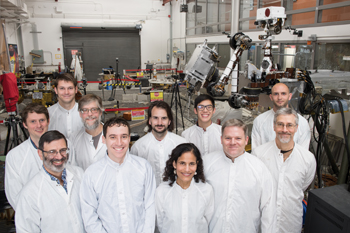 It’s always amazing to be on Mars. I have a pilot’s license and a lot of people who fly airplanes say that on the ground they’re very clumsy, but they fly well in the air. Similarly, for robots, it’s so wonderful when the rover lands and you get to see the initial results. And that’s because it operates so much more elegantly on Mars because it’s designed for Mars. Recently we took an an iconic selfie of the Perseverance rover and the Ingenuity helicopter. It is during such moments that you realize that this is working better than you imagined.
It’s always amazing to be on Mars. I have a pilot’s license and a lot of people who fly airplanes say that on the ground they’re very clumsy, but they fly well in the air. Similarly, for robots, it’s so wonderful when the rover lands and you get to see the initial results. And that’s because it operates so much more elegantly on Mars because it’s designed for Mars. Recently we took an an iconic selfie of the Perseverance rover and the Ingenuity helicopter. It is during such moments that you realize that this is working better than you imagined.
But there’s so much more that we can do. We haven’t left the solar system yet. We now have the Voyager that is pushing the boundaries. In terms of surface robotics, what I’m really interested in is getting to different planetary surfaces—things we might see with telescopes or with the Hubble. There are so many possibilities and we know so little. There’s possibility of finding life, which is what the Mars 2020 project is about. We are caching samples, and another mission is going to bring them back. That mission is going to be really interesting to work on too because that would be the first time that we bring back samples from Mars to Earth.
I have worked on some technology for Europa which will be going to the moons of Jupiter which are expected to potentially have life, and then even further beyond we are looking at Triton (Neptune’s moon) and Venus. These are very different environments. Mars is very Earth-like. But if you think of a place like Titan, where NASA is sending a flying-driving mission, it’s so dense that you could flap your arms as a human and you’ll fly. It’s a completely different environment, and I think it would be very interesting to create robots for those kinds of places as well.
And then you know, even though I work with and love robotics, someday we’re going to have humans on the moon and that will be neat. There’s just so many possibilities right now, and some of these things, especially with the outer planets, are so far out.
One of the things that surprised me is the prolonged timeline of these projects. It’s going to be 2030 by the time the samples from Mars will be brought back to Earth.
It’s like Perseverance! You start to look at things in these time horizons. It’s like you’re working on these projects when nobody in the world knows about it, but you have taken all the steps to ensure that it will succeed because it’s such a high-risk mission. And yes, it does seem like so far, yet, when you start putting all the pieces together it seems really short. For example, the code that is running on Perseverance, to move the arm and do things, I wrote some of that stuff back in 2016. So, there’re so many such steps along the way and each of them is this little spark of joy.
All this information you are getting from Mars—is it of any value to our understanding of Earth and our life here?
There’re two parts to that: one is just the science. One of the reasons why we’re really interested in Mars is to find life. I mean finding life anywhere would be incredible. We only know of life on Earth, and it would change just about everything if we would find life that’s not like us.Another reason we are interested in Mars is because at some point in the past, Mars and Earth were really similar. But now Earth is this beautiful, blue planet teeming with life and Mars is arid and dry; and it’d be great to know what happened. And more importantly, if it could happen to Earth.
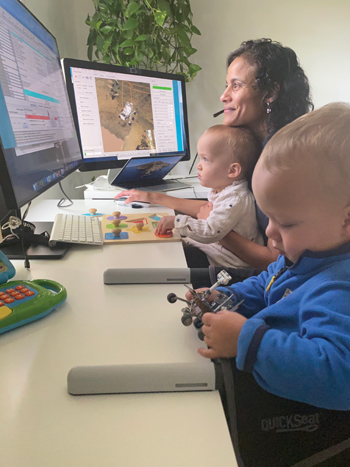 And then there’s the technology part. A lot of the things we develop for these missions actually get used in novel ways on Earth. You need them for space, but once they’re available, then they are available to everybody on a much easier-to-use basis and that’s another way in which it impacts life on Earth.
And then there’s the technology part. A lot of the things we develop for these missions actually get used in novel ways on Earth. You need them for space, but once they’re available, then they are available to everybody on a much easier-to-use basis and that’s another way in which it impacts life on Earth.
Has Perseverance made any discoveries since the time it has landed? Anything new that it has caught in the four months that it has been on Mars?
Yes, I think that literally since the moment it landed, there have been new things we discovered. But the scientific discoveries haven’t been published yet. Hundreds of scientists from all over the world are trying to figure out what they are seeing, but they would like to [explore] it before they make these hypotheses global. But we do know so many things. Just like even with flying the Ingenuity helicopter, we now have the first microphone on Mars. With the selfie that we took, for the first time we recorded sounds of the arm moving. Mars is one percent of the atmosphere of Earth, and the sound sounds different because it is traveling through air differently. That’s been interesting scientifically.
I understand that you have very young kids. So, how’s it been navigating between Mars time and Earth time with little kids?
Thankfully, we don’t do Mars time for the life of the mission. It would be extremely challenging to have a regular schedule if we were perpetually on Mars time. We only do it for a certain period.For Curiosity, we did it for 90 sols (Mars days), but for Perseverance we did it for 67 sols.We are now on Earth time. And the good thing is that my two kids, Aanya and Arjun, are still very young. So that was an advantage. Also, we were in the middle of a pandemic, so there were no school things to deal with. But we had it worked out between me and my husband, who is also working on the mission, that we would never work on the shift at the same time, because you can’t leave two-year-olds alone. So yeah, they got to be through Mars time, and they were there at the Perseverance launch, so it’s very much a part of their lives.
Hypothetically speaking if your kids, when they grow up, take up liberal arts, would you be okay with it?
Absolutely! You know the one thing that I always feel is that we should provide opportunity to every child. Don’t just give Legos to the boys, give them to the girls too. Even if they decide and choose that they want to go do something different, they’ll have done it based on their experience, not because they never saw something else as a choice.There are so many amazing things and you can pick a field that’s fascinating to you. And when people do different things, it allows you to have a broader horizon.
NASA has been known to be this white boys’ club and so,when the entire world saw Dr. Swati Mohan leading the controls operations of the Perseverance Rover mission, and then they saw you as the chief engineer of the robotic operations team, people were pleasantly surprised. Are we seeing more people from diverse backgrounds, ethnicities and gender in leadership roles at NASA?
I think that the diversity is important to have. If you have a team of people with only one type of background, you’re not thinking in creative ways. When you are doing something interesting, people with different talents and skill sets believe that this could be their future too. That is so important because we miss out if we don’t utilize the whole set of talent and we’re just getting people from a particular repeated area. So, it’s certainly changing now.
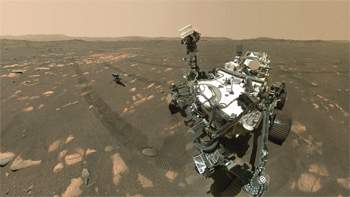 And some of it is also what we choose to highlight. I think there were women working at NASA even during the Apollo times, but it’s about valuing that contribution and making it known to people. When people choose to write about certain people and they are picking different diverse people,it encourages that behavior because people see the organization valuing diversity in thoughts and ideas.
And some of it is also what we choose to highlight. I think there were women working at NASA even during the Apollo times, but it’s about valuing that contribution and making it known to people. When people choose to write about certain people and they are picking different diverse people,it encourages that behavior because people see the organization valuing diversity in thoughts and ideas.
What would you say to people who feel that these space missions to other planets are pointless, and a waste of resources, especially when we have so many problems to deal with on Earth itself? Would you rather not use all these resources for Earth?
I don’t see it as an either-or. These missions expand our possibilities and while it may seem really far out, some of those things can completely change our lives when they come to be. Think about it: most of us are walking around with a phone which essentially is a computer with more power than most rovers. And that seemed like such a luxury not too long ago, but it has made it possible for people in rural areas to now have connectivity and access. So, some of these things we must invest in, and we need to be working on multiple things at the same time. It’s sort of like our own lives. When we have a problem in a particular aspect, we may channel a lot of resources in that direction but we don’t stop doing the other things and that’s what results in changes that can impact everything.
Are you working on any projects with the Indian Space Research Organization? Is NASA collaborating with ISRO on any missions?
There is a collaboration between NASA and ISRO called the NISAR. I haven’t personally worked on that, though. But that’s what I was saying: there’s so much to do beyond Mars. When you share these experiences while doing these missions, everyone benefits. It is so important to exchange that knowledge so that the next thing you do is bigger and better than anything anyone has done.
Deepa Agarwal is part of a Peabody Award-winning team at CNN International, where she is a Planning Producer and was formerly a full time Editorial Producer.
Enjoyed reading Khabar magazine? Subscribe to Khabar and get a full digital copy of this Indian-American community magazine.
blog comments powered by Disqus













